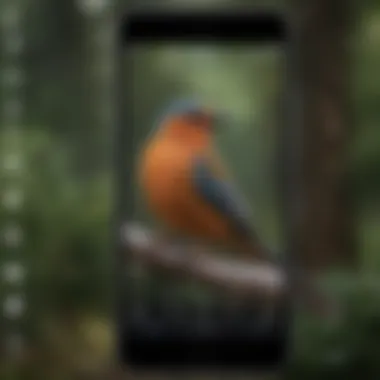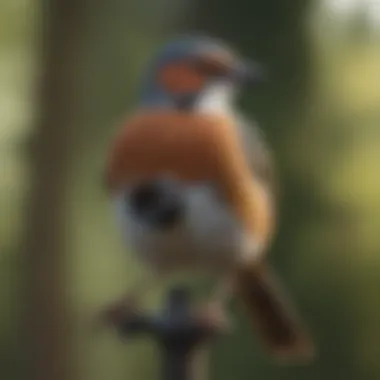Exploring Online Bird Identification Tools and Their Impact


Intro
Online bird identification has transformed the way that enthusiasts and professionals engage with avian life. The advent of digital platforms has not only made identifying birds easier, but has also fostered a more interconnected community of birdwatchers around the world. Through user-friendly applications and websites, individuals can access a wealth of information, from detailed descriptions and photographs to community discussions.
This article aims to provide a thorough analysis of the dynamics of online bird identification. By examining various tools available, and their operational mechanics, we will highlight their significance in observing birds, along with the benefits and challenges they present.
As technology advances, the methods we use for identifying birds have evolved. This has led to an increased interest in the hobby, encouraging people to venture outdoors and appreciate the diverse species inhabiting their environments. The following sections will delve into the dynamics of these platforms, focusing on how they enhance our interaction with birds and support birdwatching communities.
Understanding Bird Identification
Bird identification is a critical area of focus within the realm of ornithology, particularly as it relates to the enjoyment and popularity of birdwatching. Understanding bird identification enhances one's ability to appreciate avian species and contributes to broader ecological knowledge. In this digital age, where online platforms provide access to a wealth of information, having a solid grasp of how to identify birds is essential for both enthusiasts and professionals alike.
First, the fundamental concepts of bird identification involve recognizing distinguishing features such as size, color, and behavior. These elements together create a comprehensive picture that enables one to accurately classify a bird species. Moreover, this knowledge equips birdwatchers to better understand the habitat and behaviors of birds, which is crucial for conservation efforts.
Knowing how to identify birds accurately can significantly enhance the experience of birdwatching. Mistakes in identification can lead to misunderstanding animal behaviors or habitats. Therefore, employing sound identification practices not only enriches personal experiences but also aids in contributing valuable data to scientific communities. By fostering a culture of accurate bird identification, both amateurs and experts can support initiatives aimed at preserving bird populations.
In summary, the significance of understanding bird identification goes beyond mere observation. It impacts conservation strategies, educational outreach, and community building among enthusiasts. A well-informed individual is poised to contribute positively to ongoing avian studies and conservation movements.
The Fundamentals of Bird Identification
Bird identification is a multi-faceted process that requires attention to detail and skill. First, the most common approach to identifying a bird is through visual observation. Observers look for specific characteristics like:
- Plumage colors and patterns: Different species have distinct coloration that can change with seasons.
- Size and shape: The shape of wings, tail, and body size are vital clues.
- Behavior: Feeding habits, flight patterns, and vocalizations can all be indicative of a particular species.
Additionally, checking the geographical location helps narrow down possibilities. Resources like field guides or mobile apps offer valuable information about birds in specific regions. Learning the typical habitats of various species, such as wetlands or woodlands, can also enhance identification skills.
A progressive approach to bird identification involves both learning and practice. New birdwatchers are encouraged to start by observing common species before moving on to more elusive ones. As one becomes adept at identifying local birds, the transition to recognizing rarer species will become easier.
Why Accurate Identification Matters
The accuracy of bird identification plays a crucial role in several contexts. For enthusiasts, it elevates the enjoyment of birdwatching. A misidentified bird may lead to misconceptions about a species’ behavior or population dynamics. For conservationists, precise identification is essential in monitoring species health and population changes.
In civic science, accurate identifications contribute to databases that provide crucial data on bird distributions and trends. Such information influences conservation policy and practices aimed at protecting vulnerable species. Additionally, sharing accurate data helps create a well-informed community of birdwatchers, fostering collaboration and knowledge exchange.
"The ability to identify birds accurately is not merely a skill; it is a gateway to understanding the intricate relationships within ecosystems."
The Role of Technology in Birdwatching
Technology plays a pivotal role in modern birdwatching. It not only enhances the way enthusiasts observe and identify birds, but it also has transformed the overall experience. With the rise of various digital tools, birdwatchers now have access to an extensive pool of resources that improve accuracy, engagement, and community interaction.
In this digital age, the methods for bird identification have evolved significantly. Birdwatchers can utilize apps, websites, and other technological platforms that cater to a wide range of needs, from beginners to seasoned ornithologists. These tools enable enthusiasts to identify bird species quickly and reliably.
A Brief History of Birdwatching Tools
Historically, birdwatching tools began with simple direct observation and field guides. Early birdwatchers would carry heavy books with illustrations and written descriptions to assist in species identification. However, these methods required considerable experience and knowledge to discern one species from another, leading to potential misidentifications.
The introduction of binoculars in the 19th century provided better visibility and opened new frontiers in bird observation. Binoculars allowed watchers to observe birds from a distance without disturbing their natural behavior. Following this, into the 20th century, field guides improved, showcasing photographs and more accurate drawings that further assisted in identification.
As the internet emerged in the late 20th century, resources quickly expanded beyond physical guides. People began to share findings on various platforms. The creation of the first bird identification websites marked the beginning of a new era, one that would grow to include detailed forums and online communities.
Advancements in Identification Technology


In recent years, technological advancements have introduced powerful tools that improve bird identification. Mobile applications like Merlin Bird ID and iNaturalist employ sophisticated algorithms to help users identify birds based on images or descriptions they provide. These apps analyze user input closely, offering probable matches from their extensive databases.
Some identification tools leverage machine learning and image recognition technology. This means that not only do these apps utilize user-uploaded images, but they also learn from vast datasets of bird photographs to enhance their accuracy. As technology progresses, the accuracy of these tools is expected to improve even further.
Additionally, cloud-based resources and social networks have made it easier for birdwatchers to share sightings in real time. Platforms like eBird and Reddit, facilitate the exchange of information about where and when specific species were observed. This real-time sharing can significantly help other enthusiasts in their birdwatching endeavors.
"The blend of traditional birdwatching methods with modern technology offers unparalleled opportunities for enthusiasts to connect with the avian world."
Overview of Online Bird Identification Platforms
Online bird identification platforms have emerged as vital resources for both novice and experienced birdwatchers. These platforms enable users to connect with a broad community of bird enthusiasts while providing tools that facilitate the accurate identification of avian species. The importance of these platforms cannot be overstated, as they foster a deeper connection with nature and contribute to ongoing conservation efforts.
The dynamics of bird identification have shifted significantly with the advent of technology. Users can now access a wealth of information at their fingertips. Identification tools not only assist in recognizing different species but also offer insights into their habitats and behaviors. As such, it's crucial to explore the various categories of these identification tools and their features.
Categories of Identification Tools
Online bird identification tools can be broadly categorized into several groups. Each category offers unique methods and functionalities, catering to diverse user needs. Common categories include:
- Mobile Applications: These apps allow users to identify birds using their smartphones. Applications like Merlin Bird ID capture images and suggest matches based on user-uploaded photos.
- Web-Based Platforms: Websites such as eBird let users log sightings and access a variety of resources including range maps and bird calls. They typically offer forums for community interaction.
- Social Media Groups: Platforms like Facebook host numerous birdwatching groups where enthusiasts share pictures, ask identification questions, and exchange tips.
- Field Guide Apps: Apps designed to function as digital field guides, offering comprehensive species information, images, and audio clips to assist in identification.
Recognizing these categories helps users select the right tool based on their identification preferences and accessibility.
Popular Platforms and Their Features
Numerous platforms exist, each with unique features designed to enhance the birdwatching experience. Notably:
- Merlin Bird ID: This app is well-loved for its user-friendly interface and intelligent suggestions based on images uploaded by users. It uses a series of questions about the bird's appearance to narrow down potential matches.
- eBird: Managed by the Cornell Lab of Ornithology, eBird stands out for its extensive database. It allows users to input their own sightings while also accessing a plethora of information on bird populations and migration patterns.
- BirdNET: This platform utilizes acoustic identification methods, enabling users to identify birds by analyzing their calls. This feature is particularly beneficial for those interested in nocturnal birds or challenging species.
- iNaturalist: Although not exclusively for birds, iNaturalist encourages users to document observation, connecting them with a community dedicated to biodiversity.
Each of these platforms has its strengths, but all promote a greater appreciation for avian life.
"The blend of technology with ornithology has created unprecedented opportunities for education and conservation among birdwatchers."
Ensuring that users are aware of the range of tools available can lead to informed decisions about which one best fits their needs. These platforms illustrate the intersection of digital technology with nature, shaping a collaborative birdwatching community.
How Online Bird Identification Works
Online bird identification merges technology with natural observation, revolutionizing how enthusiasts and professionals engage with avian species. This section unveils the intricate mechanics that define this contemporary approach to birdwatching, focusing particularly on the mechanisms that empower users and enhance outcomes.
User Input and Data Collection
User input stands as the foundational element in the process of online bird identification. Birdwatchers contribute valuable data through various means, including photos, written observations, and geographical coordinates. Engaging with these platforms allows individuals to share their findings, creating a robust database that other users can reference.
As users upload data, platforms utilize this extensive input to refine identification algorithms. The format of data collection plays a crucial role here. Well-structured input enhances the accuracy of searches and yield more reliable identifications. When contributions are standardized, the processing becomes efficient, leading to quicker responses for everyone involved.
Notably, assuming quality data comes in is critical. Platforms often incorporate feedback mechanisms to assess the validity of user contributions. This ongoing process of verification contributes to the reliability of identifications, ensuring the community thrives. Users must remain conscientious about the quality of their input, making the collaboration between enthusiasts pivotal for accuracy.
Utilizing Image Recognition Technology
Image recognition technology stands at the forefront of online bird identification. This aspect of the technology employs algorithms that analyze images submitted by users. The systems recognize distinctive features of birds, such as color patterns, shapes, and sizes.
As the technology evolves, recognition accuracy improves significantly. A user might upload a photo of a bird spotted in their garden, and the algorithm quickly assesses the details. This process is not simply an identification instantaneously. It involves complex comparisons against vast databases of avian images.
Many platforms, such as Merlin Bird ID and iNaturalist, utilize these algorithms. They provide suggestions based on user-uploaded images, empowering users to learn more about observed species.


"The advancement of image recognition technology is changing the landscape of birdwatching, moving it into the digital age."
Moreover, the potential for machine learning enables these platforms to learn from user corrections over time. As more individuals engage, the database enriches itself.
The integration of user experience with technology amplifies the enjoyment and knowledge gained from birdwatching. Both user input and sophisticated image recognition are critical to the functionality of online bird identification platforms, enhancing the overall experience for birdwatchers.
Benefits of Online Bird Identification
Online bird identification has transformed how bird enthusiasts and professionals engage with their passion. The allure lies not only in the ability to identify birds more accurately but also in fostering a deeper connection to avian life. The realities of modern birdwatching have changed as digital resources become fundamental in discovering and appreciating various species.
Accessibility and User Engagement
One major advantage of online bird identification tools is the enhanced accessibility they provide. These tools are often available on multiple platforms, including smartphones and tablets, allowing users to identify birds anytime and anywhere. For instance, applications such as Merlin Bird ID or iNaturalist have made it simpler for people who might not have extensive field guides to access reliable information. Individuals with diverse backgrounds can now participate in birdwatching. This ease of access attracts a wider audience, including children and casual observers, promoting a community that shares a passion for birds.
Moreover, online platforms foster user engagement by integrating social features. Users can share their experiences, upload their observations, and seek advice from other bird enthusiasts. Such interaction creates a sense of belonging and promotes collective learning. Engaging with forums on platforms like Reddit or dedicated Facebook groups increases interest in birdwatching. Users feel motivated to explore and learn more, often leading to a heightened passion for bird conservation.
Daily posts and discussions on various species can spark curiosity and drive users to venture outside. The blend of accessibility and engagement enhances the educational aspect of birdwatching, turning it into a continuous learning experience.
Contribution to Citizen Science Initiatives
Online bird identification tools also play a pivotal role in citizen science. They allow everyday users to contribute valuable data to large-scale scientific projects. When users submit their bird sightings through platforms like eBird or BirdTrack, they contribute to databases that researchers rely on for various studies. This is crucial in understanding migration patterns, population changes, and ecological responses to climate change.
In this way, platforms function as a bridge between science and society. Birdwatchers become participants in scientific research, thus fostering a culture of responsibility toward avian conservation. Engaging in these citizen science initiatives leads to awareness about declining species and encourages users to take action. Many involved in citizen science also report increased satisfaction knowing their contributions have real-world impacts.
Challenges in Online Bird Identification
Online bird identification offers significant advantages but also presents notable challenges. Addressing these challenges is critical. Understanding them can lead to improvements in data accuracy, user experience, and the overall effectiveness of online birdwatching platforms.
Accuracy of Identifications
A primary concern in online bird identification is the accuracy of the identifications made by users. Despite technological advancements, mistakes still occur frequently. For example, distinguishing between similar species can be challenging, especially for novice birdwatchers. Misidentification can lead to significant consequences. Not only can it misguide personal observations, but it can also distort data collected for scientific purposes. Accurate identification underpins the credibility of citizen science contributions.
Several factors contribute to this issue:
- User Experience: Novices may not have sufficient knowledge to make informed identifications.
- Inaccurate Data Input: The tools rely on user input, which can be subjective and fraught with error.
- Photo Quality: Poor image quality can further hinder the identification process, resulting in unreliable matches.
Platforms like Merlin Bird ID and eBird have implemented features to address these accuracy concerns. They provide tips for identifying birds, use machine learning to compare new images with a database, and encourage users to upload clear, well-lit images. However, continuous improvement is essential for these systems to maintain credibility within the avian research community.
User Misinformation and Its Impact
User misinformation constitutes another pressing challenge in online bird identification. Multiple factors contribute to this challenge, particularly in social and community aspects. For instance, incorrect identifications can proliferate through social media platforms. When users share their observations, they often inadvertently share inaccuracies. This can mislead other birdwatchers and perpetuate false information.
The proliferation of misinformation can be detrimental:
- Impact on Learning: New birdwatchers may adopt incorrect practices or knowledge.
- Conservation Efforts: Misidentifications can skew data regarding bird populations and their habitats, leading to misguided conservation initiatives.
To combat misinformation, platforms should prioritize educational components, tutorial videos, and discussions about common mistakes. Encouraging users to consult multiple sources can foster a culture of accuracy within birdwatching communities. Platforms like Reddit and Facebook host various birdwatching groups where sharing knowledge can be managed to reduce misinformation.
"The credibility of online bird identification tools is contingent not only on technology but also on the community’s engagement and willingness to learn from mistakes."
The Future of Bird Identification Technologies
The future of bird identification technologies carries significant implications for enthusiasts, researchers, and conservationists alike. As technology continues to evolve, the capabilities for identifying and understanding avian species are expanding. The integration of advanced tools will greatly enhance the experience of both amateur and seasoned birdwatchers.


Integration with Mobile Applications
Mobile applications have revolutionized how birdwatchers interact with the world around them. With smartphones being ubiquitous, the accessibility of bird identification tools on mobile devices represents a transformative step. Apps like Merlin Bird ID and iNaturalist enable users to identify birds quickly using images, sounds, or descriptions. They provide real-time data and communal features, enriching the overall experience.
Key benefits of mobile integration include:
- Instant Identification: Users can upload photos and receive immediate feedback on species.
- Connections to Community: Many apps allow for social sharing, creating networks that support learning and engagement among users.
- Educational Resources: Features often include detailed species information, habitat guides, and field notes that help deepen knowledge.
The geographical reach also widens significantly; bird identification becomes more inclusive and collaborative. The convenience of having this information at one's fingertips can enhance user involvement.
Potential Developments in AI
Artificial Intelligence is poised to transform bird identification further. The growing capabilities of AI enable more accurate and efficient recognition of species. Current tools are already using machine learning algorithms to analyze thousands of bird images and sounds to deliver accurate identifications. This trend is likely to accelerate.
Future AI developments may focus on:
- Improved Accuracy: AI can analyze intricate features such as coloration, size, and habitat patterns more effectively than ever.
- Real-Time Learning: As more users interact with identification tools, AI can continuously learn and refine its databases.
- Personalization: AI can tailor recommendations and suggestions based on user behavior and preferences.
"AI developments in bird identification represent a dual front; enhancing user experience while contributing to broader scientific knowledge."
Community and Social Aspects of Online Bird Identification
The realm of bird identification has evolved, transcending individual pursuits to foster community engagement on various online platforms. The significance of this communal aspect cannot be overstated. It opens avenues for collaboration, education, and a collective passion for avian species. Bird enthusiasts now share a common ground, where they can contribute their findings, exchange knowledge, and participate in a larger narrative about our natural world.
Building Global Networks of Bird Enthusiasts
The emergence of social media and dedicated forums has led to the formation of vast networks of bird enthusiasts across the globe. Online platforms like Reddit and Facebook groups allow individuals from diverse backgrounds to unite under a shared interest. This interconnectedness enhances the birdwatching experience in several ways:
- Knowledge Sharing: Users can post images and descriptions of sightings, seeking help with identifications. This sharing accelerates learning and builds expertise within the community.
- Event Organizing: These networks facilitate the organization of birdwatching events, both local and international. Group participation can boost enthusiasm and motivation, leading to a richer experience.
- Resource Accessibility: Communities can compile resources like guides, articles, and tools, benefiting both novice and expert birdwatchers. This collective knowledge becomes a valuable asset.
Through these interactions, members strengthen their commitment to birdwatching while expanding their understanding of avian biodiversity.
Encouraging Conservation Through Engagement
The social elements of online bird identification platforms do not only enhance personal experiences but also play a crucial role in conservation efforts. By engaging with each other, enthusiasts can spotlight conservation issues affecting various species. Here are key points about this interlinkage:
- Awareness Raising: Sharing information about endangered species or habitat loss fosters greater awareness. Users can participate in campaigns advocating for environmental safeguards.
- Citizen Science Contributions: Many platforms support initiatives where amateur birdwatchers contribute valuable data to scientific research. Participating in these projects emphasizes the impact individuals can have on conservation.
- Mobilizing Action: Engaged communities can organize local clean-up efforts or habitat restoration initiatives. Collective action amplifies individual efforts, making a tangible impact in local ecosystems.
Engagement in online bird identification communities leads to higher awareness and proactive measures for conservation initiatives.
The social dynamics established through these platforms foster not only a sense of belonging but also a shared responsibility towards protecting avian life. Such initiatives have the potential to shape the future of bird conservation and encourage a lasting appreciation for the biodiversity around us.
Culmination
The conclusion of this article serves as a pivotal section, underscoring the critical importance of online bird identification in modern birdwatching. As technology evolves, the tools available for bird enthusiasts enhance not only their experience but also their understanding of avian life.
Summarizing Key Insights
Throughout this exploration, several key insights have emerged regarding the dynamics of online bird identification. First, the accessibility of various platforms has democratized birdwatching. Tools like Merlin Bird ID and iNaturalist allow users of all ages and skill levels to engage with nature. This increase in accessibility fosters a community where information is shared, leading to collective learning.
Furthermore, the use of advanced technologies has shifted traditional practices. Image recognition and user-generated data contribute to more accurate identifications, enriching the overall experience. The balance between technology and nature remains crucial, as users navigate through the integration of digital tools in their outdoor activities.
Implications for Avian Studies
The implications of online bird identification tools extend beyond personal enjoyment. The data collected through these platforms contributes significantly to avian studies and conservation efforts. Citizen science initiatives rely heavily on user engagement, providing researchers with valuable information about bird populations and their behaviors.
Moreover, as more enthusiasts participate in these online communities, the potential for educational outreach increases. Understanding migration patterns, breeding habits, and habitat preferences becomes more approachable with the help of digital resources.
In summary, the conclusion emphasizes the profound impact of online bird identification on avian studies and the importance of continued engagement in this area. The blending of technology and enthusiasm for birds not only enriches individual understanding but also supports conservation efforts on a larger scale.















